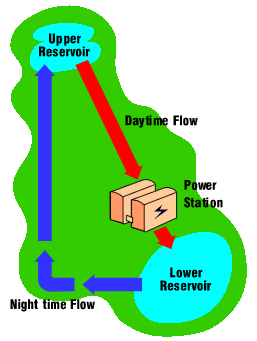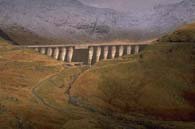


| Storage Options |
Reasons for storage Pumped Storage Compressed air Flow batteries
Batteries Superconducting magnetic Flywheels Hydrogen Conclusions References
Reasons for storage
The major weakness of electric power is that it must always be used at the exact time at which it is produced. Managing the balance of supply and demand is therefore a complex problem - resulting in the inherent monetary value of electricity changing by the hour. Storage helps marginally competitive resources such as many renewables overcome these limitations, and can also improve the economic efficiency of the entire grid system as a whole.
In general, renewable energy sources are intermittent or vary in intensity throughout the day. Much of the generated power from renewables is not coincident with the peak demand, and so renewables (especially wind) tend to experience lower prices in the wholesale market due to their inability to guarantee levels of power delivery.
Storage may be used in some of our Baseload Supply Strategy scenarios, to enable a smoothing out of peaks and troughs in order to supply a steady baseload.
back to top
Hydro-electric pumped storage
Principles
Pumped hydro-electricity storage is on of the oldest and largest of all the commercially available energy storage technologies. It is a method of storing and producing electricity to meet high peak demands, working on a simple principle. Two reservoirs at different altitudes are required. When the water is released from the upper reservoir, the downward flow is directed through high-pressure shafts, linked to turbines. The water turns the turbines, which then power the generators to produce electricity.

In storage mode, water is pumped back to the upper reservoir by running the generator backwards. The electricity used to do this is usually cheap off-peak power, normally occuring at night (when demand is lowest). It can then be used to meet daily peaks in demand. About 70% of the electrical energy used to pump the water into the elevated reservoir can be regained in this process.
A new concept being developed is wind-pumped water storage which allows variations in wind power to be levelled by using the wind power to fill the upper reservoir and then generating grid power from the reservoir turbines.
The pumped storage system makes economic sense, as it enables flattening of variations in the load on the grid, permitting thermal power stations such as coal-fired plants and nuclear power plants that provide base-load electricity to continue operating at capacity.
It's predictability and rapid response also time make it an important component in supply to the national grid. It can store large capacities of electricity for long periods - a typical plant can store it's energy for more than half a year if necessary. Partly due to the large scale and the relative simplicity of design of pumped storage, the operating cost per unit of energy is among the cheapest of the storage options currently available.
In assessing hydro developments, it should be remembered that they require a very large initial capital outlay, although this is followed by a long lifetime with high reliability and low running costs. They are also limited by their dependence on specific geological formations. Due to the nature and location of these formations, construction can be difficult and grid connection expensive. There are also environmental implications in terms of the land that is required to be flooded, and the disturbance to the local habitat due to water level fluctuating daily.
back to top
Scottish supply
Cruachan Power Station, near Oban in Argyll, is one of only four pumped storage power stations in the UK. It is concealed in the hollowed-out area of the mountain Ben Cruachan. As shown below, only the 316 metre-long dam and the offices are visible from the road.
 Accessed by a tunnel seven metres wide and four metres high, the power station cavern houses
four generator/motor sets capable of generating 400 MW of electricity.
Accessed by a tunnel seven metres wide and four metres high, the power station cavern houses
four generator/motor sets capable of generating 400 MW of electricity.
Although it can be used as a conventional hydro plant, using run-off water from the mountain, it is more commonly run in storage mode - it's reversible turbines pumping water up to the upper reservoir from Loch Awe using cheap electricity, so that peak demand can be met the following day. The station has an excellent response time, able to produce electricity for the grid in two minutes flat - or just 30 seconds if the turbines are on "spinning reserve" (turning in air, awaiting the rush of water) - enabling surges in demand to be accomodated.
back to top
Compressed air energy storage (CAES) using gas turbines
The basic principle of this storage means is to use low-cost off-peak power in place of the more-expensive gas turbine-produced power to compress the air for combustion.
The off-peak power pressurises the air into an underground reservoir - a salt cavern, abandoned hard rock mine, or aquifer. This air can then be released during hours of peak demand, for use in a gas turbine to produce power.
In a gas turbine, roughly two thirds of the energy produced is used to pressurize the air, but as CAES systems have no need for air compressors connected to the turbines, they can produce two to three times as much power as conventional gas turbines for the same amount of fuel.
CAES have a number of advantages:
- They can be used on very large scales - facilities can be sized in the range of 50-300 MW.
- Apart from hydro pumped storage, no other storage method has a storage capacity as high as CAES. The storage period is the longest as the losses are very small - a CAES system can be used to store energy for more than a year.
- Fast start-up - CAES has the ability to start-up in around 12 minutes under normal conditions (compared to conventional combustion plants of 20 to 30 minutes).
- If a natural geological formation is used, the installation cost is relatively small.
- The green house gas emissions are much lower than in normal gas plants.
back to top
Flow batteries
Flow batteries - or regenerative fuel cells - can store and release energy through a reversible electrochemical reaction between two salt solutions (electrolytes). These systems are good for storage of real power (MW), but poor for delivery of reactive power (MVAR) quickly. Various electrolytes have been used, including zinc bromide, vanadium bromide, and sodium bromide (NaBr). The battery is charged as electrical energy from the grid is converted into potential chemical energy. Within the electro-chemical cell, there is a separate compartment for each electrolyte, physically separated by an ion-exchange membrane to allow release of the potential energy to occur. The cycle is a closed loop, so there is no discharge, and the size of the storage is limited by the size of the electrolytic tanks.
back to top
Batteries
There are a number of battery technologies for storage use on a utility-scale. Lead acid is the dominant battery type, although other batteries such as sodium sulphur and lithium-ion are also available. Batteries are electrochemical cells composed of two electrodes separated by an electrolyte. When a battery is discharging, ions from the first electrode(anode) are released into the solution and oxides are deposited on the second electrode (cathode). To recharge the battery, the electrical charge is reversed, returning the battery to its original condition.
back to top
Superconducting magnetic energy storage (SMES)
SMES systems store energy in the magnetic field created by direct current flowing in a coil of cryogenically-cooled superconducting material. Such a system requires a superconducting coil, a cryogenically cooled refrigerator and a vacuum vessel. It is claimed that these systems are 97-98% efficient and they can provide both real and reactive power. SMES systems can store energy with a loss of only 0.1% per hour, compared to a loss of around 1% per hour loss for flywheels. They can recharge in minutes and can repeat the charge/discharge sequence thousands of times without any degredation in the magnet, with recharge time being tailored to meet specific requirements depending on system capacity. Such storage facilities are used to provide grid stability in a distribution system and for maintaining power quality at advanced manufacturing plants.
This is an emerging storage technology, and developments to date have been reasonably small scale. However, some projects using SMES on a larger commercial scale are in development, which will be beneficial in terms of reducing the unit cost through economies of scale. Currently, systems can store around 10 MW, although research has proven higher capacities in the region of hundreds of MW to be possible, but for very short timescales.
As superconductivity does not produce a chemical reaction, and no toxins are produced in the process, SMES systems have environmental advantages. SMES systems are useful in improving the power quality for critical loads and providing carryover energy during voltage sags and momentary power outages.
back to top
Flywheels
Flywheels store energy by accelerating a rotor to a very high speed and storing this energy in the system as inertial energy. The rotor must be low weight and allow for the extremely high speeds, so it is manufactured from advanced composite materials. The energy is released from the flywheel by reversing the process to use the motor as a generator, so that the rotor gradually slows down until it is discharged.
Some flywheels are currently commercially available, but there is still a lot of research being done into design improvements. Idling loss, due to external forces such as gravity when the flyweel is spinning on standby is one problem. This requires a pushing force to maintain the flywheel speed - though in commercial applications this loss is usually less than 2%. Zero idle-loss machines are possible, but they turn at low speeds. These flywheels only produce 5-10 kW of power. Size is a consideration, as flywheels are often relatively large, and currently do not have very large storage potential.
back to top
Hydrogen
There are concepts in development for the conversion of energy from remote renewables to hydrogen gas via electrolysis of water. This process is about 65% efficient. This gas could then be collected by a tanker on a set schedule, and brought to a central station to power fuel cells connected to the grid. There are safety concerns over the flammability of hydrogen. However, it is less hazardous than petrol, and this concept overcomes the problems of installing expensive offshore transmission facilities, and may even make more sites viable. It is thought likely that discharges would normally occur once per business day (250 times per year), allowing a block of power to be sold into the peak daily market. Once the storage facility was fully charged, it could also be used as emergency back-up for the grid, enabling axploitation of another revenue channel. However, the efficiency of this process is a concern, and in addition, this technology is still under development and will not be available until some time in the future.
back to top
Conclusions
The table below compares some of these storage options:
| Pumped Storage | Compressed air | Superconducting magnetic | Flywheels (high speed) | Hydrogen | |
| Capital Cost $/MWh | 7,000 | 2,000 | 10,000 | 25,000,000 | 15,000 |
| Efficiency | 0.8 | 0.85 | 0.97 | 0.93 | 0.45 - 0.8 |
| Capacity | 22,000 MWh | 2,400 MWh | 0.8 kWh | 750 kWh | 0.3 to 2000 kWh |
| Maturity | Mature commercial | Commercial | Commercial | New Commercial | Commercial |
In terms of maturity and availability in Scotland, hydro pumped storage currently appears to be the most viable storage technology. However, in future, as technology advances, the other storage options may become important components of a marine current system.
back to top
References
- Matti Juvonen (2003-02-07), http://www.doc.ic.ac.uk/~mpj01/ise2grp/energystorage_report/node2.html
- The Institute of energy (2002), Energy Storage - where do we go from here?, London, Institute of energy.
- Susan M. Schoenung (March 2001), Characteristics and Technologies for Long- vs Short-term energy storage, DOE Energy Storage Systems Program.